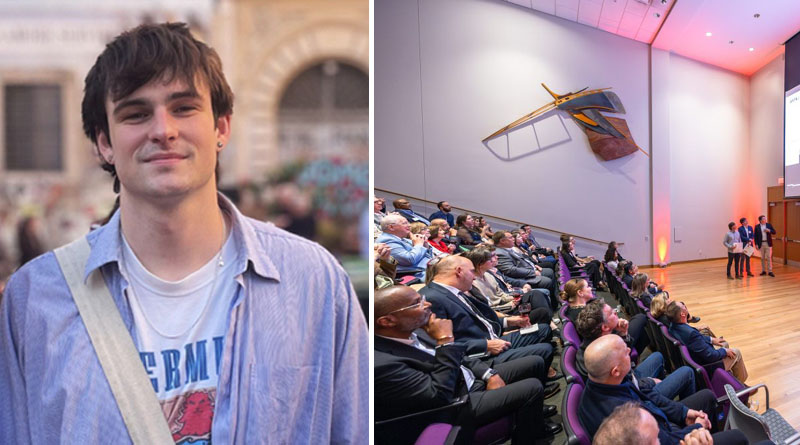Charlotte Architecture’s “Great Ambassador” Is Franklin Bell
When Franklin Bell and his teammates, Jonathan Kadau and Tom Wileman, confronted their final architectural design project this semester, they decided to take an experimental approach. Tasked with placing “an urban library for the collection and exhibition of maps and books” in a certain Roman piazza, the three students designed a building that “almost became a map” itself, Bell said.
Bell, Kadau and Wileman are all graduating in May after spending their spring semester in the David R. Ravin School of Architecture’s Rome study abroad program. It was an extraordinary culmination of their education at UNC Charlotte.
“Rome is really a city about layers,” said Bell. “And the way people live in Rome – there’s such a sense of community and togetherness. To feel that while we were there, it allowed us to work in a different way.”
The library assignment “allowed for a lot of freedom of expression,” he said. “Even though the assignment was specific, there was a lot of variation in how people approached it. Everyone felt they had the freedom to try new things.”
When Bell reflects on his four years in the School of Architecture, the word “freedom” comes up frequently. It is, in fact, the school’s reputation for openness and innovation that attracted him. “I had heard that UNC Charlotte had a more experimental approach, pushing the boundaries. There’s a lot of freedom at Charlotte that might not exist in other architecture programs.”
Bell had studied drafting in his Alamance County high school, but during the second semester of his freshman year at UNC Charlotte, he was encouraged to experiment with new ways of drawing.
“It opened up what I thought was possible in the profession,” he said.
The next year, he enrolled in the Integrated Path to Architectural Licensure (IPAL) program, a rigorous academic track that provides students the opportunity to complete the experience and examination requirements for licensure concurrently with the academic requirement. IPAL students are matched with local architecture firms for paid internships during their undergraduate studies, then work full-time for one year after graduation before returning to UNC Charlotte to complete a Master of Architecture degree.
Bell was placed with DLR Group his sophomore year. His first experience there was a “massive high school project” on the Gulf coast of Alabama.
“I was thrust into a scale of project I had never worked on before!” he said.
DLR Group, which oversaw the restoration of the newly opened Carolina Theater in uptown Charlotte, is known for its work in the performing arts sector as well as the healthcare industry, and Bell has more recently been involved in theater renovations in Tampa, Florida. Upon graduation he will continue working at DLR Group and over the course of a year will take the six examinations required for his architectural license. He will come back for graduate school at UNC Charlotte in the fall of 2026.
Bell is eager to stay connected to the School of Architecture and says “all the faculty are amazing.” David Thaddeus, director of the IPAL program, has been a great resource for “navigating professional life.” Marc Manack, undergraduate program director, “pushes me to move forward, move forward.”
Prompted by Manack, Bell has twice entered work in the student competition for the American Institute of Architects (AIA) Charlotte Design Awards – and twice won.
The 2024 award was for his independent project, “Tiny House Factory,” but the year before he shared the award with teammates Jonathan Kadau and Tom Wileman for a proposed addition to the McColl Center.
Just as in Rome, teamwork was both challenging and rewarding.
“Architecture students can be headstrong, but we were able to make it work,” Bell said.
Bell thinks he will one day teach architecture.
“I love the academic setting. I enjoy helping people try to understand things.”
He is inspired by his parents, who are both educators, and by professor Thomas Forget, associate director of the School of Architecture.
“He’s always been present in my educational journey,” Bell said of Forget. “I think he saw in me something – a desire to learn – and he’s really pushed the boundary of what I can do.”
Forget praises Bell’s combination of “raw talent and exceptional habits.”
“Franklin channels his innate design sensibilities through a work ethic that leads him to truly remarkable work that is routinely shown to younger students as examples to which to aspire,” Forget said. “Meanwhile, as a participant in our IPAL program, he is contributing to practice in ways that belie his youth. Franklin is a great ambassador of our program who will achieve much in our discipline and continue to make us proud.”

